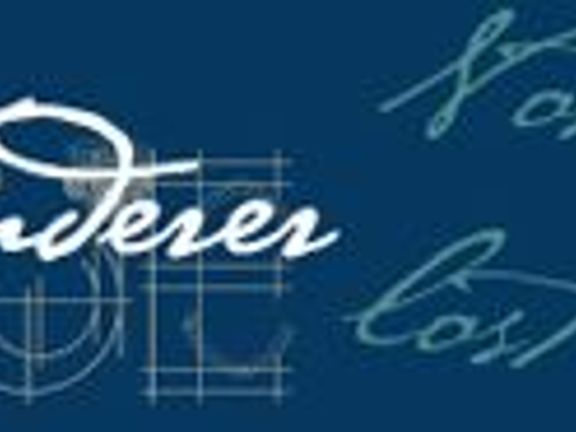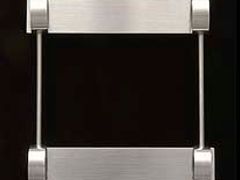Prague - For a person whose work is built around simplicity, Eva Eisler is a very complicated woman.
A jewelry designer and artist, she titled her 1990 brooch collection the Tension Series, which included a brooch that is in Washington D.C.'s Smithsonian American Art Museum.
The brooch is made of two rectangles of stainless steel sitting about two inches apart with thin cylinders of sterling silver linking the smooth planes to form a perfect square.
According to the Smithsonian website, the piece was inspired by Eisler's fascination with bridges. She admires their physical construction, as well as the metaphor of connecting the unconnected. The website explains, "The invisibility of the connecting pieces allows the artist to suggest another kind of 'tension' in the viewer, who might wonder how the pieces hold together."
This same description could apply to this 56-year-old Czech artist, who established her career in New York before moving back to Prague three years ago.
Eisler's signature style of geometric shapes and simplicity permeates her office—from her cube-shaped ashtray to the black shelves holding her books and jewelry. When she speaks, she focuses her eyes on the empty desk space in front of her. She traces shapes on the surface and uses her hands to pull imaginary ideas together.
Dressed in black, her jewelry stands out. She wears a large, stainless steel ribbon choker—a long, flexible piece of steel that wraps around the neck several times. Her bracelet is a wide, smooth piece of steel. Her brown hair skims her shoulders and her rounded rectangular glasses give her a symmetrical look reminiscent of her art. She is polished and stylish, but in an effortless way.
Eisler's life is filled with tensions. When speaking her, Eisler's friends, family, and colleagues present an image of the artist as free but focused, demanding but generous, opinionated but open, and simple but complicated.

More at Prague Wanderer
When asked if she returned to the Czech Republic—after 23 successful years as an artist in New York—to give something back to her country, agitation immediately washes over her calm demeanor.
"Why? Why?" demands Eisler, "[The communists] didn't let me study here, they kicked my mother out of her job, and they kicked my brothers out of school. I had nothing to give back, but I am here to share my experience and I'm not going to share with people that are not curious about it, but [with] students [in] my field where I can pass something on to them."
How did she put the anger behind her? She looks surprised at the mention of anger. "I was never angry. I was very sad, very sad. Anger was never part of my life. I was hurt."
Agitated, but not angry. Collected but wounded. Her Tension Series might as well be called "Life."
Eisler was born in Prague in 1952 to an artist mother and a scientist father. She planned to study architecture and graphic design at UMPRUM, Prague's Academy of Arts, Architecture, and Design, but was denied the education when her father fled the country.
He had requested to extend his two-year contract teaching mechanical engineering at Manchester University in England, which the communist Czechoslovak government denied. After he returned to Prague, he continued to persist until one day, while on the tram going to his office, he read in the newspaper that he had defected from Czechoslovakia with stolen government documents.
He went home and asked Eisler if she wanted to go skiing—that day, in Austria. Surprised by the question, Eisler told him she had exams the next week and would go with him next time.
"And that was the time when he left. He didn't tell my mother, he didn't tell my brothers. He invited me to go with him, but he didn't tell me why. But he was leaving, like, leaving," says Eisler.
Eisler says her father acted out of fear and the belief that his job was the most important thing for him in his life. Under the communist regime, his departure had severe repercussions for Eisler's family. Her mother lost her job, her brothers were kicked out of university, and she was prohibited from attending UMPRUM.
She says her father believed he could do more for the family if he was not in jail. To Eisler, this was no excuse. "I said, 'No, it's unacceptable. You hurt my mother and you hurt my brothers, you hurt us all.' But, later on, when I grew up, I forgave him," says Eisler. "And I understood why he did it and then I also realized that every one of us, we have our life and we have to [make] the best out of it."
And that is precisely what she did. In 1972, she met John Eisler, born to a British mother and a Czech father, and the couple had two children, Martin and Marek.
In 1983, the government granted the Eislers permission to leave for one year when John was invited to work at a New York architectural office.
After a year, they applied to the Czech embassy in New York to extend their stay but were denied. Like her father, she decided to stay abroad and make the sacrifice of not being able to see family and friends.
"During communism, we didn't come here at all, because we stayed abroad without [the] permission of the Czechoslovak government," says Eisler. Returning to Prague would have meant two years in prison. They did not return until 1991, after the collapse of communism following 1989's Velvet Revolution.
In New York, Eisler began to fuse her architecture with her interest in jewelry. "In the 1980s, everything that was kind of architectural was accepted very seriously and nobody in the United States did jewelry this way," says Eisler.
When she was ready to show her work, she opened the yellow pages and looked up design schools. She randomly picked New York's Parsons School of Design, met the department head, and was soon independently studying there.
Next, she visited the Helen Drutt Gallery in Philadelphia, which was widely considered to be the most important gallery of the time for contemporary art jewelry. Eisler showed her work to Drutt, who surprised her by offering to represent her in the gallery. She accepted and began her path to New York success.
Toni Greenbaum, a New York art historian specializing in 20th and 21st century jewelry and metalwork, met Eisler soon after she moved to New York. Greenbaum says Eisler's work "melds the precision and spirituality of geometry." In comparison to other artists, Greenbaum has seen "many imitators, but no one approaches [Eisler's] quiet perfection."
Now a world-renowned artist-jeweler, her creations range from lamps to bracelets. Her pieces can be found in museums all over the world, including Montreal's Musee des Beaux Arts and New York's Metropolitan Museum of Art.
Eisler's distinct handiwork, especially her use of stainless steel as if it were ribbon, is instantly recognizable. "What is unique in her work is that you can recognize it at first view. It's her style. It's not comparable with others," says Helena Koenigsmarkova, the director of Prague's Museum of Decorative Arts. She says that when someone walks into a room wearing one of Eisler's pieces, she immediately thinks,"Oh, you have Eva."
After bouncing back and forth between Prague and New York for years, Eisler and her family decided to settle in Prague, where she quickly integrated into the art scene. She designed a permanent exhibition at the Czech National Gallery's branch at Schwarzenberg Palace in Prague. Eisler's most recent endeavor is the creation and organization of an exhibit called "My Europe." Eisler is overseeing 40 artists' interpretations of Europe—41 including her own. The exhibit opened in Brussels over the summer and is currently enjoying a one-month stay in the main lobby of Prague's Cernin Palace, the Ministry of Foreign Affairs. On October 7, it will move to the DOX Center for Contemporary Art in Prague, where it will be on display until November 18.
DOX director Leos Valka, who has known Eisler for 10 years, is confident in Eisler's ability to coordinate it.
"She is the archetype example of today's turbo-cosmopolitan, moving easily from different contexts and environments," says Valka about Eisler. "She represents a new breed of artists—someone who is confident, someone who hasn't got an inferiority complex. She's not timid about what she does."
When asked about her Tension Series, Eisler responds in an e-mail, "[It] was inspired by the idea of freedom. You can take pieces apart and put them together in a different configuration or use it as a kit and build it yourself."
The brooches in Eisler's Tension series look like tiny stainless steel bridges. For some, bridges are considered the epitome of tightness, stability, and immovability. But not for Eisler. While they may represent the ability to connect the unconnected, her bridges can be taken apart and changed; they can make as many connections as the artist can make configurations. So, ultimately, Eisler is the architect of her own tension.
This story was originally published by the Prague Wanderer, a web-zine run by New York University students in Prague, Czech Republic.
Christina Ng is a junior at New York University. She is double majoring in journalism and dramatic literature and minoring in politics. She is from Cincinnati, Ohio.








